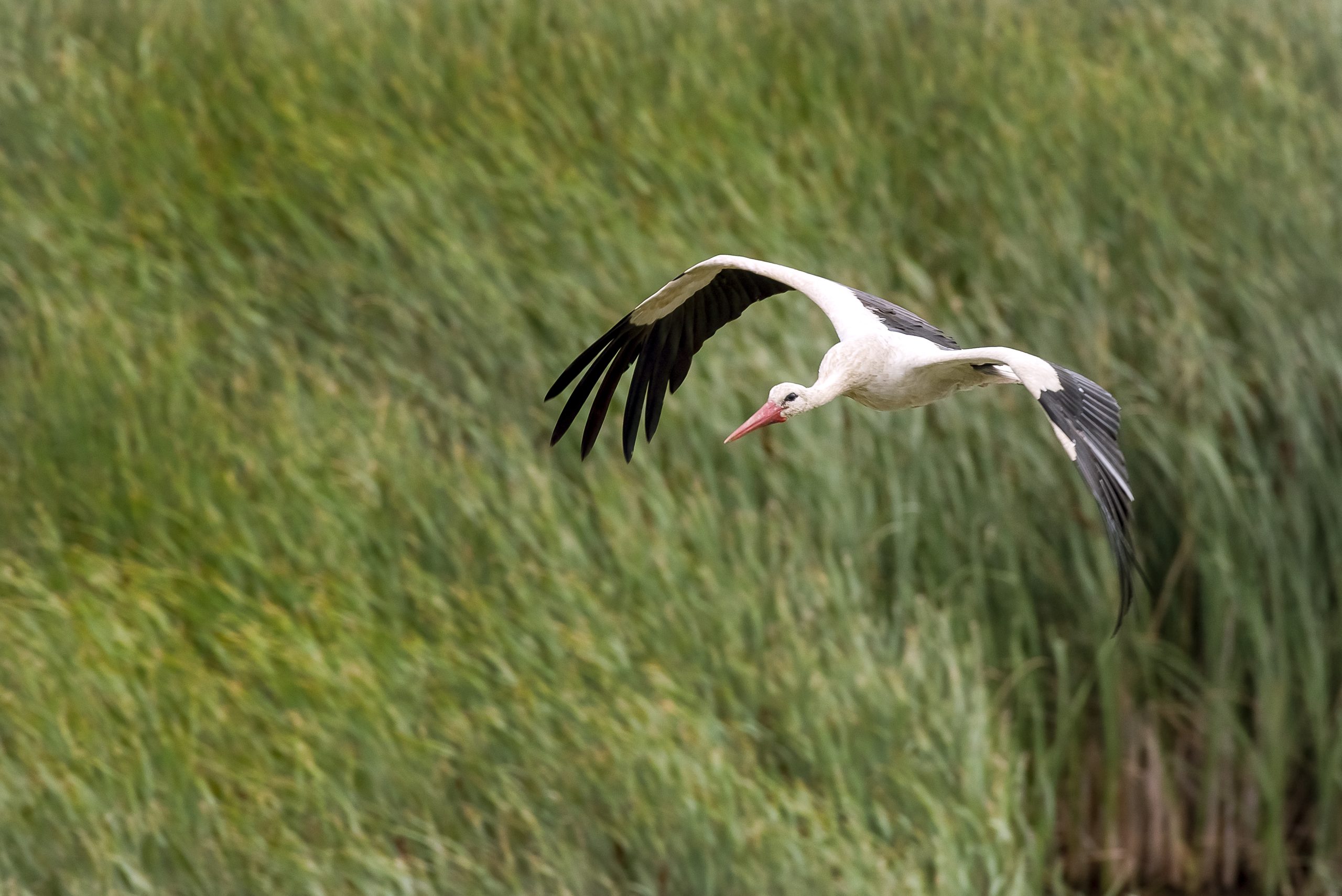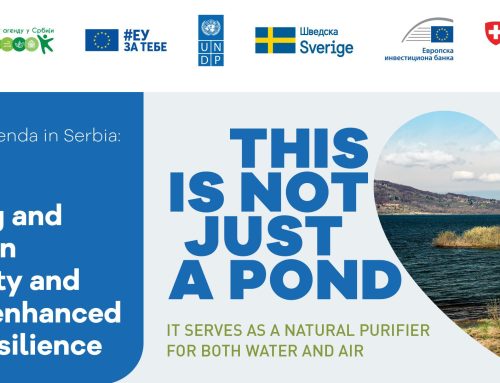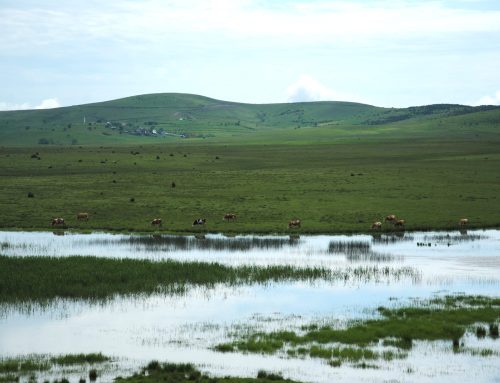In Serbia, wetlands are one of the most valuable natural resources, but at the same time they are also the most endangered ecosystems. Their survival is further threatened by urbanisation, changing agricultural practises such as soil drainage to create arable land, excessive use of pesticides, and climate impacts such as droughts and the reduction of water flows.
To ensure the long-term conservation and sustainable use of wetlands, decision-makers need to objectively analyse the root causes of these threats and base their decisions on relevant data and scientific research.
The first important step in this process is to create a comprehensive inventory, i.e. to collect and analyse data that will enable us to understand the state of the wetlands, identify the threats and priorities for conservation, and plan the appropriate measures. Thanks to the support of the Kingdom of Sweden, within the project EU for the Green Agenda in Serbia: Protection and investment in biodiversity and water in order to strengthen resistance to climate change implemented by UNDP in cooperation with the Ministry of Environmental Protection, this important task will be completed in the next two years.
The value and importance of creating an inventory
Wetlands in Serbia include swamps, ponds, peatlands, floodplains and river deltas, such as the Zasavica Special Nature Reserve, the Obedska Pond and the Pešter Field. Each type of wetland has specific environmental functions, such as storing carbon (peatlands), regulating water flows (floodplains) and providing habitat for rare bird and plant species (swamps). Creating a wetland inventory is the basis for scientifically sound decisions on nature conservation. According to Jelena Dučić, Head of the Biodiversity Department at the Ministry of Environmental Protection, this process consists of collecting data on the location, type, status, environmental character and threats to which the wetlands are exposed.
“This data is necessary to monitor the state of ecosystems, identify threats, and plan the measures to help mitigate climate change. In addition, the inventory will enable a more efficient management and restoration of wetlands and serve as a reporting tool for international treaties such as the Sustainable Development Goals, the Paris Agreement and the Kunming-Montreal Global Biodiversity Framework,” explains Dučić.
The Ramsar Convention, the international treaty on the conservation and sustainable use of wetlands, obliges member states, including Serbia, to identify and protect wetlands of international importance. The List of Wetlands of International Importance, also known as the Ramsar List, is the central instrument of the Ramsar Convention. It contains wetlands that are recognised for their environmental, biological and cultural value, as well as their importance for global biodiversity and the protection of migratory birds.
Serbia currently has 11 wetlands on the Ramsar Convention List, with a total area of over 120,000 hectares. These wetlands include the Ludaš Lake, the Obedska Pond, Old Begej – the Imerial Pond, Slano Kopovo, Labudovo Okno, the Pešter Field and Đerdap, which is the last to be declared a Ramsar site in 2020. In addition to the Ramsar sites, the Institute for Nature Conservation of Serbia and the Provincial Institute for Nature Conservation have so far categorised more than 60 areas with wetlands on their territory.
However, although Serbia has signed the Ramsar Convention and is committed to conserving these important areas, the last comprehensive wetland inventory was created in 2006, almost 20 years ago. This means that the data urgently needs to be updated, as many ecosystems have changed significantly in the meantime due to urbanisation, climate change and other influences.
The process of creating a wetland inventory involves several crucial steps to ensure comprehensive and systematic data collection. First, wetlands are located, identified and mapped using geospatial information and satellite imagery. Then, detailed data on biology, chemistry, hydrology and land use are collected through field research. Finally, all the data collected is analysed to identify the risks and threats to the habitats and develop appropriate protection and conservation measures. The first national wetland inventory will collate and process all wetland data collected so far and, where necessary, update data or collect new data. All data will be integrated into a digital platform that will contribute significantly to the efficient management, conservation and restoration of these ecosystems.
The ministries and institutes for nature conservation are responsible for planning and prioritising wetlands to be included in the List of Wetlands of International Importance according to the criteria of the Ramsar Convention. The Institute for Nature Conservation of Serbia and the Provincial Institute for Nature Conservation use the data obtained to prepare studies for the designation of new protected areas, to define the conditions for nature conservation, to implement projects for the improvement of natural habitats and for outreach and educational purposes.
The national project Development of an Environmental Network in the Republic of Serbia
The project Development of an Environmental Network in the Republic of Serbia will directly contribute to the fulfilment of commitments under the Ramsar Convention, as it involves the identification and conservation of wetlands and other ecosystems that are crucial for the preservation of biodiversity. The goal of this project is to create a national environmental network connecting protected areas, including wetlands, in order to ensure their survival and restoration, but also to maintain the ecological connections between them.
“As part of this national project, funded by the Ministry of Environmental Protection and coordinated by the Institute for Nature Conservation of Serbia in cooperation with the Provincial Institute for Nature Conservation and scientific institutions, data was collected between 2015 and 2024. This data collection led to the entry of a large amount of digitised data on habitat types and plant and animal species into the information system of the Institute for Nature Conservation of Serbia. This data will be evaluated and contribute to the creation of a centralised inventory as a register of organised data on wetlands in Serbia,” said Jelena Dučić.
Birds as a key indicator of the health of wetlands
Ornithology plays an important role in the creation of a wetland inventory, as birds are a key indicator of the value and health of these ecosystems. The number, diversity and behaviour of birds directly reflect the quality and conservation status of wetlands. A healthy wetland ecosystem harbours numerous bird species that feed, nest and migrate in this area. However, changes in the number and type of birds living in a particular wetland may indicate changes in the quality of these areas or threats such as pollution, climate change or habitat loss.
Marko Tucakov, ornithologist at the Provincial Institute for Nature Conservation, emphasises that many bird species are directly dependent on wetlands, especially during certain phases of their life cycle.
“Even the smallest bodies of water, including the temporary ones, are very important for birds because in ecosystem food chains, birds are mostly level one consumers (herbivores) and level two consumers (carnivores and omnivores). Unfortunately, many carp ponds in Vojvodina, which used to be important habitats for birds, are now in decline due to changes in agricultural practises and climate influences,” explains Tucakov.
The task of an ornithologist is to determine the number and species of birds living in a particular area through long-term monitoring. This forms the basis for evaluating the habitat according to the criteria of endangerment and conservation.
Challenges in creating an inventory
“The biggest challenges in Serbia are no different from the challenges in other countries, in Europe or worldwide. These are mainly the lack of capacity and resources, and failing to understand the importance of an inventory. In addition, the very steps of creating an inventory, such as the definition of its elements, data management protocols and the structure of the process, can also pose a major challenge,” says Jelena Dučić.
| International cooperation However, international cooperation offers the opportunity to exchange experiences and learn from countries where this practise is more developed. Evaluation according to international standards makes it possible to compare the situation in Serbia with the situation in other countries and to plan measures accordingly, based on the practises that have led to results. At the end of November 2024, Serbia participated in the conference organised by the German Agency for Nature Conservation and the Ramsar Convention in Bonn, where examples of good practises in the creation of wetland inventories across Europe were presented. Jelena Dučić says that the experience from this conference will be useful in defining the methods and tools for creating the national wetland inventory. “Various approaches were presented, such as the Mediterranean Wetlands Initiative (MedWet), which offers concrete methods for collecting and processing data. These examples of good practise can serve as a model for a more efficient inventory in Serbia,” says Dučić. The Mediterranean Wetlands Initiative (MedWet) aims to protect and sustainably manage the wetland ecosystems in the Mediterranean region through research, creating inventories and conservation of these areas. This initiative promotes cooperation between countries, development of policies to create a balance between nature conservation and the needs of local communities, and raising awareness of the importance of wetlands for biodiversity, water resources and climate stability. |
Creating a wetland inventory is not just an administrative task, but a strategic process that ensures the preservation of natural resources for future generations.
Once the wetland inventory is completed, the next step is to analyse the data collected to assess the state of the wetlands and identify conservation priorities. Based on this data, conservation and management strategies will be developed, including preventive measures against threats such as urbanisation and pollution. In addition, a system will be set up to monitor the impact of the conservation measures implemented. It is very important to involve local communities and relevant stakeholders in the conservation process. This includes education, cooperation, and the adoption of legal frameworks that enable the efficient protection of wetlands. Such a comprehensive approach enables the long-term sustainability and conservation of ecosystems that are crucial for biodiversity, water resources and the stability of local communities.
This text was produced as part of the campaign for the conservation of wetlands in Serbia “It’s not just a pond”, implemented with the financial support of Sweden, represented by the Swedish International Development Cooperation Agency (Sida), within the “EU for Green Agenda in Serbia” project. This project is implemented with the technical and financial support of the European Union and in partnership with the Ministry of Environmental Protection by the United Nations Development Programme (UNDP), in cooperation with Sweden and the European Investment Bank (EIB), with additional funding provided by the governments of Sweden, Switzerland and Serbia.
Photo: Vladimir Dobretic PZZP



